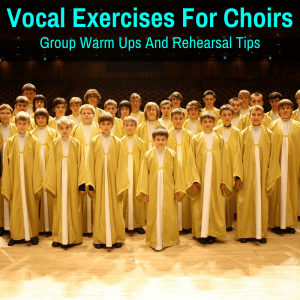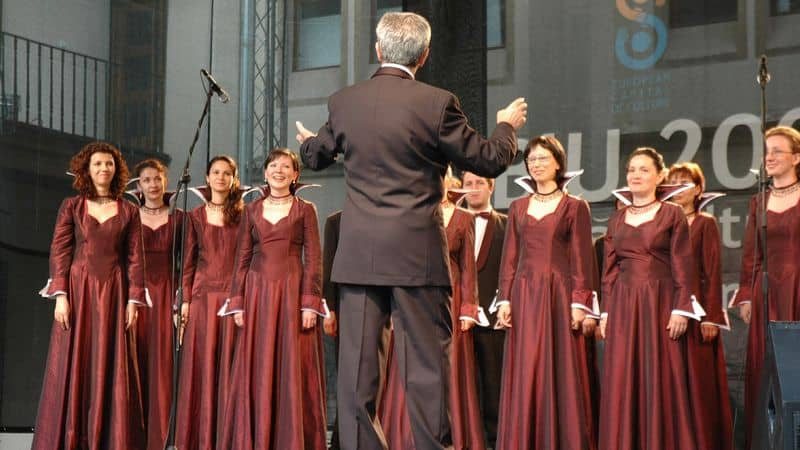 Getting an entire choir to warm up together is not always easy.
Getting an entire choir to warm up together is not always easy.
Most singers will want to warm-up on their own and this should not necessarily be discouraged.
But warming up together as a group, in addition to any individual warm-up exercises, is highly beneficial.
When creating a warm-up routine for a choir, it is important to allow the expressive, free voice to come out.
Especially with young singers.
Generally, a healthy voice will emerge naturally and it is best to stay out of the way and let that sound emerge.
My experience with the exercises below is that they address the dictum: do no harm. The sound that I hear from this vocal procedure is clear, in tune, free, and pleasing. Singers are encouraged to sing individually with a sensitivity to the group sound.
Table of Contents
Choral Vocal Warm Ups
When warming up your choir, start with the body as a whole, then move on the the breath, the nose and the vocal chords.
Warm Up The Body

Before anything else, you need to prepare the body for singing. The following exercises accomplish this.
- Stand quietly. Take a “sun breath.” As you inhale through the nose (to the count of 4) raise your arms, keeping shoulders comfortably relaxed. If you are able to do so, touch your hands over your head. Exhale through your mouth to the count of 4 while gradually lowering your arms. Over time increase the count to 6 and then 8. As you become comfortable with the exercise, add a 4-count hold at the top of the inhalation.
- Gently shake your wrists. Flop your wrists in front of you. Shake your hands more vigorously as if trying to get water off them.
- Roll your shoulders in a circular manner up and back.
- Extend one arm in front of your body fingers pointed up. Pull gently to free the wrist. Point the fingers down. Pull gently to free the wrist. Repeat with the other arm. (Also good for conducting.)
- Clasp your hands together behind your head. Gently pull down on your head while exhaling. (Caution: Those with neck injuries, take care with this exercise or avoid it completely.) Lift your elbows and head while inhaling through the nose. Repeat slowly 3-4 times.
- Turn 90 degrees to the right, facing the back of your neighbor singer. Rub the shoulders of the person in front of you. Turn around and repeat the process.
- Finally, stand quietly with arms relaxed at your sides. Take a full breath while bringing your arms overhead. Keep shoulders comfortably down and relaxed. As you exhale, lower your arms, keeping sternum elevated and shoulders down. Your posture is somewhere between the typical “teen slump” and the stereotypical “military rigid.” The body is now awake and in a position for effective singing.
These exercises are several from the many effective exercises that singers can do to ready the body for singing.
They generally work well in close quarters and are designed to bring a state of readiness to the body with special attention to relaxing muscles in the neck which attach to the laryngeal cartilages. Freedom and readiness are the issues: free the voice and ready the body.
Prepare The Breath For Singing

Once the body is alert and has been energized through physical warm-up exercise, it is time to wake up the breath. These following exercises are effective at doing so.
- Place your palms on the bottom of the rib cage, fingers crossing the abdomen and touching in front. Breathe low and deep, observing that the fingers separate as the result of an effective inhalation. Hiss, long and sustained, keeping the rib cage and sternum elevated.
- Inhale and hiss, five times staccato.
- Inhale and hiss, twice staccato and then sustained.
- Inhale and sing on a comfortable pitch in mid-voice, “Sah-sah-saaaaaaaaaaaah.” (Sing twice short and then sustained.)
- Inhale and sing on a comfortable pitch in mid-voice two staccato pitches, “Sah-sah” followed by a sustained five-pitch scalar passage (5-4-3-2-1) on “Saaaaaaaaaaaaah.” Repeat several times, each time a half step lower, remaining generally in mid-voice range.
- Hold your hand up in front of your face fingers spread. Imagine that each finger has a candle lit at the end. Blow out the candles one by one with five staccato breaths.
- Toss an imaginary ball to someone across the room. As you throw, exhale with a hiss.
- Toll an imaginary bell. As you inhale through the nose, reach up. As you exhale audibly through the mouth, pull down on the imaginary bell rope.
(These exercises come from the Ehmann/Haasemann book listed below.)
The intent of these vocalizes is “vocal-ease.” Breath flow needs to be uninhibited and immediately connected to the sound.
The flow of breath may be imagined as water pouring forth freely from a garden hose. The sound on the breath is as a leaf on the stream of water, carried effortlessly and completely connected to the stream of water.
Observations About Breathing
- Never plan to use all of your breath. The singer who sings to the last milliliter of breath may well have done so at the expense of introducing tension into the voice or body, not to mention a likely sacrifice of expressive singing. The “last gasp” of breath is rarely connected to easily produced sound, and it is generally unmusical.
- The issue with breathing is not who can sing the longest phrase, although it certainly is a goal of vocal pedagogy to increase the length of phrase that can be sung. The primary issue with breathing is to keep a smooth, consistent stream of sound always connected to breath.
- Young voices may be naturally breathy. Don’t be overly concerned about breathiness in young singers. Listen to the sound that is produced “under” the breathiness. Vocal maturity may solve the problem.
- Avoid holding back the breath. Give the breath into the phrase. Holding back the breath to “save it” for the end of the phrase may lead to vocal tension and erratic voice-breath connection. Ironically, the more breath you give to the phrase, the more breath you have to give.
- Coordinate the breath with vocal onset, so that the sound is neither breathy nor tight.
- If the sound is too breathy, try “narrowing” the vowel concept, singing a very rounded [u] for example. (Remember–point #3 above–that young voices may be naturally breathy
- If the vocal onset is tight, use an aspirated consonant [h] to assist vocal production. Rather than [a] sing [ha]. Gradually reduce the intensity of [h] in the sound until the [h] is only imagined, not audible.
- Maintain the body in its upright and ready posture. (See below: appoggio)
- Oversupport can cause as many vocal problems as undersupport.
- For posture: “Sing in the position of breathing––breathe in the position of singing.”
- Take an easy, silent breath.
- Yawning is normal: you may find yourself yawning a lot at first and asking: “Why do I yawn when I sing?”, but this is perfectly normal and nothing to worry about.
- Breath holding may increase lung capacity, but will not enhance breath management.
- If the vocal onset or release is jagged or erratic, move the hand in an upward sweeping motion to encourage a smooth onset or release of sound.
- If the vocal release is tight or constricted, keep the throat open after phonation; imagine that you are continuing to sing, even after you have released the sound.
The Italian concept of appoggio is roughly translated as “support,” but appoggio is much more: a dynamic balance of abdominal and thoracic muscle movement, coordinated with vocal onset (phonation), which allows cooperative (antagonistic) coordination among the muscles. Its features are:
- an elevated sternum, never slumped
- ribs expanded and maintained, as much as possible, in the “expanded” position during exhalation
- shoulders, neck, and head relaxed
- torso stable in the epigastric and umbilical regions
- relaxed glottis
Prepare The Nose for Singing

Now that the body is ready and energized for singing and the breath has been vitalized, it is time to prepare the nose.
The Italian maxim goes something like this: “Put some nose in the sound without the sound being in the nose.” Virtually everyone agrees that, in the bel canto style, nasal singing is avoided. The converse is also true: “cut-off nasality” is to be avoided.
Nasal sound has a twang that is generally out of place in classical singing. On the other hand, the sound of “cut-off nasality” is dull and monochromatic, flat (not in pitch but in resonance). In a balanced voice there is some nose in the sound, but the sound is not nasal.
A good test is to sing and pinch the nostrils. If the sound doesn’t change at all, there is no nasality in the sound: it has “cut-off” nasality. If the sound changes a lot, there is a nasal twang: it has too much nasality.
If the sound changes slightly, then the balance is probably right. This is a tricky concept to teach. Studio voice teachers use a variety of techniques to get the right mix of nasality in the voice.
In a choral setting I have found that the best way to “wake up the nose” is through a humming vocalize. Ask the singers to bring the lips gently together as if humming [m]. Place the tip of the tongue easily behind the upper teeth as if singing [n].
Hum using this combination of [m] and [n]. Experiment in mid-range with random humming sounds, single pitches and gentle glissandos. Use the humming “puppy whine” in upper register as a means of developing nasal placement and as a technique to connect with head register.
Once singers are comfortable with humming, introduce this vocalize: 5-3-4-2-1 (sol-mi-fa-re-do) in major mode and in a comfortable mid-voice range. Hum the first four pitches and sustain the final pitch on the vowel [a]. Repeat several times a half step lower each time, but remaining in a comfortable range.
Another useful vocalize on the same pitch pattern (sol-mi-fa-re-do) or a more extended pattern (sol/mi – fa/re – mi/do – re/ti – do) is [ni-ne-na-no-nu] sung while doing gentle circular gestures with your hands in front of the body as if lovingly stroking a cat.
Observations about Resonance
- A resonator is a secondary vibrator, not capable of initiating pitch, but capable of altering the amplitude and timbre of the pitch for better or worse. If the voice doesn’t sound good or if it is not projecting well, it may be because the resonators are not well adjusted.
- Resonance adjustment (the tuning of the cavities of the mouth and throat) is often most effectively done through vowel modification. For example, if the [ah] vowel is too bright, modify it to [aw].
- If the resonating cavities (primarily mouth and throat) are not tuned to the pitch from the vocal folds, then the vocal folds must “force” the air cavity to vibrate, rather than vibrating in sympathetic resonance with the voice. Forced resonance is inefficient for singers; sympathetic resonance is the goal.
Warm Up The Voice
Once you have animated the body, initiated consistent breath flow, easily connected breath to sound and energized the nasal placement, it is time to extend the range of the vocalizes to awaken the full range of the voice.
There are numerous vocalizes that effectively achieve the goal of vocal extension. The two that I use most frequently with choirs are these:
- This arpeggio: do-mi-sol-do-ti-sol-fa-re-so sung on these syllables: [u – – – a – – – -]. The ascending arpeggio is on [u] and the descending arpeggio on [a]. At the same time move your hands in a big “rainbow” arch, beginning in the middle of your body and radiating outward.
- The scalar passage: 1-2-3-4-5—1-2-3-4-5—1-2-3-4-5-6-7-8-9-8-7-6-5-4-3-2-1 on these syllables: [si – – – o], [si – – – o], [si – – – o – – – – – – – – – – – -]. On the first five pitches, each time make a small circle with the hands in front of the body; on the 9-notes scalar passage make a big circle with the hands, again radiating outward. Note: this exercise may not be as effective if sung too quickly.
Observations
- There is something about movement of the body that exerts a positive influence over the sound that is produced, energizing it with freedom and connection to the breath.
- When the voice is “cold,” it is best to begin the vocal warm-up with descending vocalizes in mid-range. This procedure, especially with inexperienced singers, will more consistently deliver vocal sounds that are free of tension and on pitch.
Make The Choir Sound Beautiful

Once you have animated the body, initiated consistent breath flow easily connected to sound, energized the nasal placement and extended the range of the vocalizes to awaken the full voice, it is time to focus on vocal beauty. Notice the order: vocal beauty is the last important vocal component to be addressed.
The exercise that I use most often for beauty of sustained singing is a single pitch in mid-voice, first hummed pianissimo and then sung with gradual crescendo on a succession of vowels that grows increasingly brighter: [u – o – a].
If the vowel is truly unified, somewhere in the [a] an overtone (or sometimes two) emerges as a result of the vowel unification. When this happens, the choir is truly singing in tune.
For optimum sound, think in this order:
- Breathe
- Sing
- Sustain
- Release
For optimum resonance, encourage the following:
- A comfortably low larynx
- A high velum
- Balanced nasal placement
- Relaxed lips
- Relaxed tongue
For beautiful sound and optimum resonance, use the following:
- the look of pleasant surprise on your face
- the look of hopeful anticipation
- the beginning of a smile
- the appearance of inhaling a pleasant aroma, such as a rose
Doing all of these exercises every day will probably require 10-15 minutes and you may not have that much time in rehearsal. I generally use a 20-25% rule of thumb for vocal warm-up and sight-singing exercises. If your rehearsal is 50 minutes, take no less than 10 minutes for vocal and musical exercises.
Find a plan that works for you and stick with it. Slight variations from day to day are good, but in general keep the routine the same; in the long run that will produce the most consistent results.
Research has demonstrated the value of singing every day. The vocal exercise does not have to be complex: easy humming in the shower or simple scalar passages in the car on the way to work are effective; certainly more extensive vocalizing is needed for more rigorous singing. The benefit of humming is holistic: somehow we feel more integrated and grounded.
Characteristics Of A Good Choir Voice

- Pitch-centered. Singers can and should sing to the center of the pitch.
- Free. Good singing feels and sounds effortless; unnecessary vocal tension is released.
- Beautiful and resonant. Exercises that encourage a comfortably low larynx, a high velum, “forward” placement, relaxed lips, and relaxed tongue will contribute to a naturally beautiful sound.
- A pleasing vibrato. In Seashore’s classic definition, “A good vibrato is a pulsation of pitch, usually accompanied with synchronous pulsation of loudness and timbre, of such extent and rate as to give pleasing flexibility, tenderness, and richness to the tone.” Pitch fluctuation in a healthy vibrato is about a semitone with about six undulations per second. A vibrato that is too rapid is called tremolo; one that is too slow is a wobble. Vibrato is a result rather than a technique. When the voice is free, breath-centered, pitch-centered and resonant, vibrato emerges; it is not taught. Vibrato is a sign of a healthy voice. In Miller’s view it is acceptable to call attention to unhealthy vibrato, so that a singer may correct it.
Much debate among singers, singing teachers, and choral conductors has centered on the topic of vibrato. I believe it is possible for good choral union and vibrato to peacefully coexist (consult recordings of The Robert Shaw Chorale or the Swedish Radio Choir with Eric Ericson conducting as examples).
Straight-tone singing to the point of “laser-like” vocal production (as I have heard in some choirs) is unhealthy and unpleasant. Likewise, a vocal free-for-all in which singers are allowed to do anything and everything with vibrato does not yield the most satisfactory choral sound.
A Note About Blend
A chorus learns to sing together to the extent that members of the chorus have developed unified concepts of pitch, vowel, diction, rhythm, articulation, dynamics, balance and timbre. In rehearsal I encourage all singers to:
- Sing precisely the same pitch.
- Sing precisely the same vowel.
- Sing exactly the same rhythm (with special attention to consonants).
- Sing a unified articulation: staccato, legato, marcato, or tenuto
- Sing a unified dynamic level.
- Be sensitive to the need to balance all voice parts.
- Sing with a unified timbre, bright or dark.
Suggestions For General Health
- Aerobic conditioning assists vocal conditioning. When you exercise, you oxygenate the capillaries throughout the body, including the larynx, and singing is enhanced. Caution: Consult a health-care professional before beginning a program of aerobic exercise.
- Hydration assists good singing. A water bottle is a good companion.
- Avoid dehydrating substances: antihistamines, alcohol, and caffeine.
- Eat foods that focus on the dietary pyramid: high on fibrous fruits, whole grains, and vegetables; low on “bad” carbohydrates and “bad” fat. Much more in this article on a singer’s diet.
- Take a good multi-vitamin supplement.
- Avoid foods that produce mucous, milk products especially.
- Speak at an optimum pitch for your vocal health. The voice can be damaged if speaking pitch is too low or too throaty. More in this article on avoiding vocal damage.
- Warm-up the voice daily. A few descending vocalizes, humming and singing (perhaps in the car on the way to work) will help ready the voice for a day of teaching.
- Whispering is hard on the voice.
- Avoid clearing your throat, a very rough experience for the vocal folds.
- If you are not well, stay home and rest. Don’t teach while ill or vocally impaired.
- Avoid getting a cold, an annoyance to the general population, deadly for a singer. Avoid touching your eyes and nose as these are good conduits for infection. Wash hands frequently, especially during cold season.
Some Principles Of Vocal Training
- Don’t badger the sopranos about vowel color in high range. Because of the fixed formant principle, all vowels in women’s voices tend toward [a] in upper range.
- The most difficult singing is piano or pianissimo. The next most difficult singing is fortissimo. Most singing, especially in developing voices, is best at mezzo forte.
- Ideally singers desire to coordinate the voice from top to bottom in one seamless passage. All singers have two basic registers: heavy and light, often called chest voice and head voice. Training the voice to produce this seamless passage generally requires bringing the lighter production or head voice down into the lower voice and, conversely, taking weight out of the sound as you move from heavier production, or chest voice, into the upper voice. Generally, descending vocalizes work best to achieve this balance of vocal registers.
- Generally men need to be encouraged to use the falsetto range. They shy away from it because the sound is not manly.
- Generally women need to be encouraged to use the chest mechanism. They are reluctant to sing in chest voice because the sound is not sweet enough.
- Avoid the terms “break” or “lift” to describe the shift in vocal registers. Use instead “vocal passage” or passaggio. According to Miller, the primo passaggio is at the top of the natural speaking voice; the secondo passaggio is at the top of the “yell” register, where the voice passes to falsetto. (His text on pp.115-126 contains a very thorough chart of vocal classifications and passaggi.)
- The word “cover” is often used to describe the passage of the male voice into the upper range. Characteristics of cover include vowel modification (toward more closed vowel formations); a spacious pharynx, high velum, and low tongue (described above under “optimum resonance”); a lowered larynx, and greater air & air pressure. Avoid a forced lowered larynx (as in a deep yawn). The concept of “cover” almost defies description and is best explored in the hands of an experienced teacher of voice. See below (Suggestions for Rehearsal) for a description of a technique for unifying registers in the male voice through descending falsetto exercises. This is a safer technique to use in group situations.
- These consonants are most favorable for developing vocal resonance: [m] and [n]
- These consonants are most favorable for assisting vocal onset: [h], [s] and [f]
- To sing “problem” consonants––[l] and [r]––think of [l] as a light [d], substituting, for example, “addeduia” for “alleluia.” Produce [r] with the flip of the tongue or with a substituted [d], singing “vedy” in place of “very,” for example.
- “Tongue trills” will bring freedom in the tongue. “Lip trills” simulate the action of the vocal folds and assist with vocal onset and vocal freedom.
Suggestions For Choir Rehearsal
- Sing the phrase from end to beginning. This will build your confidence to finish the phrase without losing breath.
- Sing the piece from end to beginning to build confidence in the conclusion of the piece.
- At the first rehearsal of a piece, start with that section of the piece that you find most beautiful, most expressive, or most exciting.
- At concert time the focus must be on expression, not technique. Rehearsal builds vocal (and choral) technique. The singer in concert who focuses on technique risks boring the audience.
- In developing agility, begin with simple exercises and proceed to more complex.
- Of the many techniques that I have encountered for singing passagework (the melismas in Handel’s Messiah, for example) the one that I like best is a lightly produced [nah]. The ideal, of course, is to sing the passages clearly and on the breath, “like pearls on a string.” Amateur singers are often challenged to do so. In my experience rehearsing such passages on [nah] produces clarity without sacrificing vocal health. The [nah] must not be audible to the audience. It is the responsibility of the conductor to coach the chorus as to what is too much and what is not enough. Some singers may be encouraged to sing the passages with [nah] while others may sing the pure vowel.
- One technique for blending the male voices in a choral setting is to ask the men to sing a descending major scale beginning in falsetto. First ask the women to sing a descending A Major scale, beginning on A=440. Then ask the men to sing with the women at pitch (men in falsetto). Finally ask the men to sing alone. Beginning with the support of the women may encourage the inexperienced tenors and basses to experiment in a vocal range that is unfamiliar to them. Blend and pitch will be mutually supported with this exercise. At the point of vocal passage from falsetto to head voice, add an extra measure of breath, not breath pressure, to ease the transition.
- If the head voice is the underdeveloped register in males, the chest voice is in females either underdeveloped or used exclusively. For those women who use chest voice exclusively, some commit the Cardinal Choral Sin: singing tenor. Most every choral conductor who has conducted inexperienced or developing choirs has at some point asked women to assist the tenors in singing their part. That is not a crime, because much of the tenor line lies comfortably in the alto range some of the time. The crime is asking, or allowing, women to sing tenor exclusively, developing only the chest voice to the exclusion of the head voice. However, the converse is also true: Some women never use the chest voice and thus lose a powerful vocally expressive part of the voice. Chest voice is a legitimate register, and as long as the voice is not pushed high using exclusively the chest register, it is safe and effective to use this register. All women, sopranos included, should be encouraged to develop all of the voice: head and chest registers. The only danger is when chest voice is pushed too high in the range, generally agreed to be a pitch around f’.
- The technique of “choral roving,” assigning singers to move to a different vocal line, has been used effectively to create balance in a choral ensemble. Allowing baritones to sing tenor occasionally, altos to sing tenor occasionally and sopranos to sing alto occasionally is not only good musical training, it makes for a better choral sound, as long as the voice continues to be used in a healthy manner. I have upon rare occasion moved tenors to baritone and tenors to alto, and, even rarer, altos to soprano. I have never asked basses to sing soprano.
- Conducting gesture affects the sound that you get: legato, tenuto, staccato, marcato. If you ask the choir to sing legato, determine that your gesture is not marcato.
- Train in this order:
- Tune a single pitch.
- Tune a brief descending scale, sol-do.
- Tune an extended, faster scale.
- Tune a sustained chord.
- Tune a series of chord changes.
- Tune a phrase.
- Tune a song.
You can’t sing a song in tune until you sing a phrase in tune. You can’t sing a phrase in tune until you can sing a scale in tune. You can’t sing a scale in tune until you can sing a pitch in tune.
If you feel that the choir is singing with a generally healthy sound, but intonation is still a problem, try simplifying the musical demands according to the suggested order above.
Vocal Warm Ups For Choir: Final Thoughts
This was a heavy article. Probably the heaviest on this site. But we wanted to give you the most comprehensive article on choir exercises possible.
Even if there are far too many exercises here for your particular situation, we hop you at least find a few useful warm ups, etc. among them.
Suggested Reading
- The Choral Warm-Ups of Robert Shaw
- Choral Warm Ups on the Voice Science Works website
- Pick ‘n’ mix warm-ups for choirs on the Total Choir Resources website
- Ehmann, Wilhelm and Frauke Haasemann. Voice Building for Choirs. Chapel Hill, NC: Hinshaw, 1982. — THE text for group vocal techniques.
- Miller, Richard. The Structure of Singing: System and Art in Vocal Technique. New York: Schirmer, 1986. — Excellent descriptions of vocal problems & suggested vocalises.
- Doscher, Barbara. The Functional Unity of the Singing Voice. Metuchen, NJ: Scarecrow Press, 1988. — Excellent descriptions of vocal function.
- Vennard, William. Singing: the Mechanism and the Technic. New York: Carl Fischer, 1967. — Excellent, though highly technical.
- Alderson, Richard. Complete Handbook of Voice Training. West Nyack, NY: Parker, 1979. — Less technical discussion.
This is one of the most useful online articles I have found on this subject. It is thorough without being overly long. Many articles I have found before don’t say much more than “stay relaxed and be sure to warm up first.” Thank you for this. I will be coming back to it time and again to review.
Thank you for the kind words! I’m so happy you found the article useful.